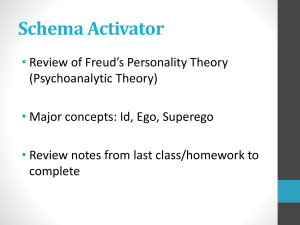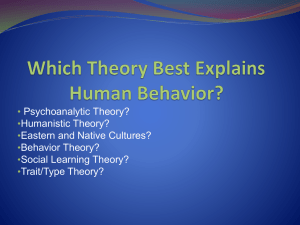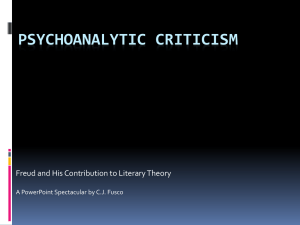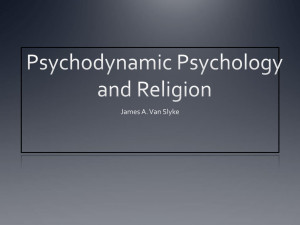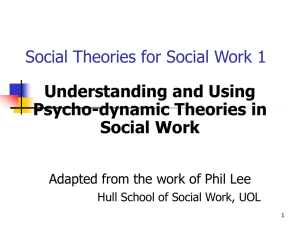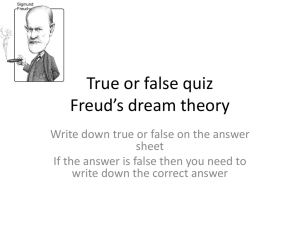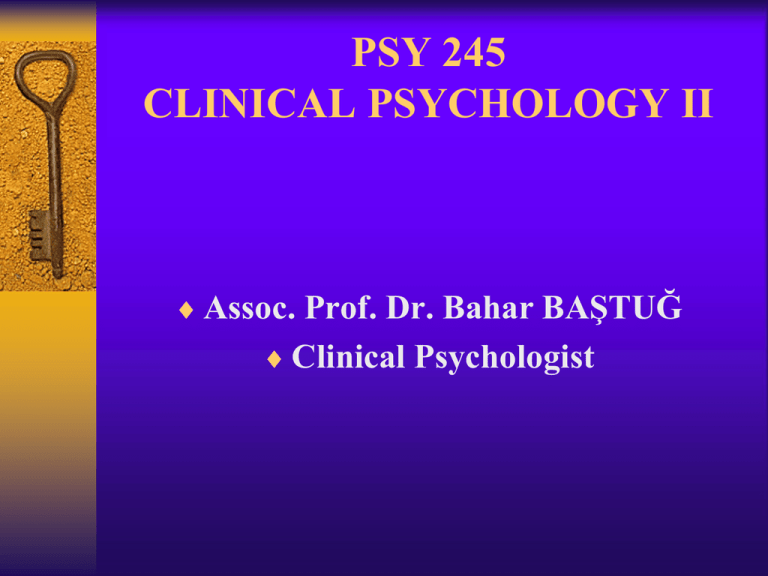
PSY 245
CLINICAL PSYCHOLOGY II
Assoc. Prof. Dr. Bahar BAŞTUĞ
Clinical Psychologist
Psychoanalytic Approaches
Today we’ll be focusing on psychoanalytic
and psychodynamic theory and practice,
beginning with the work of Sigmund Freud.
As an interesting starting place, say the first
word that comes to mind when you hear:
“Sigmund Freud.”
Sigmund Freud (1856-1939)
Sigmund Freud
Freud was born in Freiberg, Moravia, in 1856, he
died for larynx Ca in 1939 in London.
His intellectual potential was obvious early on and
Freud felt like a favored child.
He obtained his medical degree from the
University of Vienna with the goal of being a
research scientist.
He went into private practice of neurology
because of financial needs.
As a neurologist, Freud was exposed to the
disorder “hysteria” .
Sigmund Freud
He became familiar with the work of Jean
Charcot, who was using hypnosis to
produce hysterical symptoms. Professor
Charcot of Paris' Salpêtrière demonstrates
hypnosis on a "hysterical" patient.
For Freud, the same procedure
might be used to treat hysteria.
Sigmund Freud
Freud began working with Viennese physician
Josef Breuer. Breuer was treating hysteria
symptoms by having patients talk about
emotionally loaded childhood experiences. Breuer
worked with Anna O., discussing her hysteria
symptoms and treatment in great detail with
Freud. They published Studies in Hysteria in
1895.
Anna O.,
or Bertha Pappenheim,
1880
Hysteria was the main psychological
disorder of Freud’s time.
Psychological theories are a product of the
dominant Zeitgeist and Ortgeist.
He initially used hypnosis, but later became
more enamored with the “talking cure.”
Freud’s Early Fascinations:
• Psychosexual Development
• Unconscious Sexual Meaning of Many Behaviors
Sigmund Freud
Freud presented a paper titled “The Aetiology of
Hysteria” in Vienna in 1896. He made a
connection between childhood sexual abuse and
later psychopathology.
The Seduction Hypothesis suggested that
childhood sexual abuse produces later
psychopathology (Hy).
« at the bottom of every case of hysteria there are one or more
occurrences of premature sexual experience” (Freud, 1896, cited
in Masson, 1984, p. 263).
Freud’s presentation of the Aetiology of
Hysteria met with an “icy reception.”
He abandoned the Seduction Hypothesis in
favor of his theory concerning the Oedipal
conflict.
Theoretical Principles
Freudian Theory
• Is one of the “Giant theories” of developmental
Psychology (Miller, 2010).
• Is a one-person intrapsychic model.
• Includes several different approaches to thinking
about human behavior.
Psychoanalytic Theoretical Principles
Classical Freudian theory is a one-person
intrapsychic model that treats the client as a
separate, individual artifact to be
systematically and objectively examined.
X
X
X
X
X
X
X
X
Modern analytic theory treats the therapy
encounter more as a two-person field,
wherein the therapist’s and client’s
intrapsychic and relationship interactions
help shed light on patterns that may be
troubling the client.
The Dynamic Approach
is known as drive theory or instinc theory. He
believed humans are filled with mental or psychic
energy.
This energy comes from two essential sources:
Eros
energy associated with
life and sex
Libido
Thanatos
energy associated with
death and aggression.
Eros and thanatos are
the two basic drives
that energize behavior.
According to drive (dynamic) theory,
Psychic determinism underlies the dynamic
approach (“. . . nothing happens by chance”
[Brenner, 1973]).
every impulse has an origin, aim, object, and
intensity.
An impulse always originates from some place in
the body. Child – oral
Their aim is to obtain oral pleasure.
The pressure or intensity of pleasure need is
building.
The baby finds an object that will allow him
or her to discharge tension and obtain
pleasure.
According to drive (dynamic) theory,
if the internalized cycle does not flow
smoothly due to parental withholding, there
can be a fixation and later unconscious
acting out of the pathological cycle during
adulthood.
Repeated patterns may result in an internal
working model or repetition compulsion.
The Topographic Approach
Divides the mind into three interrelated regions:
the unconscious,
the preconscious,
the conscious.
The Topographic Approach
There is much more going on at the unconscious
level than at the conscious.
Awareness of our basic, primitive sexual and
aggressive impulses might disrupt our daily lives,
our brain protects us from them. The main purpose
of psychoanalytic therapy is to help us slowly
become aware of unconscious impulses. By
bringing unconscious impulses to awareness,
we’re able to manage them, because even when
they are outside awareness, primitive impulses can
still act on us in an indirect and destructive
manner.
Oedipal conflict X Electra Complex
Resolution of this conflict leads to
development of the superego.
The Developmental Stage Approach
Explains how early childhood experiences
influence later adult behaviors.
Oral: birth to 1 year old
Anal: 1 to 3 years old
Phallic: 3 to 5 years old: Oedipus complex
Latency: 5 to 12 years old
Genital: adolescence to adulthood
The Developmental Stage Approach
Each stage is defined in terms of the part of
the body around. Each stage presents new
needs.The way in which these needs are met
(or not met) determines not only how sexual
satisfaction is achieved, but also how the
child relates to other people and how he
feels about himself. Unresolved conflicts in
any stage may bother the person throughout
his lifetime.
The Developmental Stage Approach
All children progress through all developmental stages.
Progress through the stages is driven by biological
maturation. At each stage, if parents are overly tolerant
or withholding, the child can end up with fixations or
complexes associated with the stage. A fixation or
complex is an unresolved unconscious conflict.
The Structural Approach
involves the interrelationships of:
• Id: Pleasure principle – primary process
• Ego: Rational thought – secondary process
• Superego: Conscience + ego ideal
The id is the centre of biological desires. It
functions on the pleasure principle and primaryprocess thought. Id impulses are unconscious. We
can view id impulses within ourselves via dreams,
fantasies toward pleasure-seeking behavior. The id
is the mother of the ego.
The Structural Approach
Ego functions include memory, problem-
solving ability, and rational or logical
thought processes. These functions are
defined as secondary thought processes.
The superego develops around the time
when children resolve their Oedipal issues
and begin strongly identifying with parents
and parental demands or expectations.
The Structural Approach
There are two parts of the superego:
1.the conscience develops as a function of parental
prohibitions. When mom, dad, or another authority figure
says, “No!” or “Stop that!”, these warnings are internalized
within the child’s psyche and later used by the child to
self-punish or prohibit unacceptable impulses. It becomes
the inner source of punishment.
2. In contrast to the negative, punishing quality of the
conscience, the ego-ideal is a positive desire.
The conscience is a punishment as a motivator, while the
ego-ideal is a reinforcement as a primary motivator.
The Structural Approach
The ego acts as a mediator between the id
and the superego.
This is no easy task, and therefore the ego
often must use defense mechanisms.
Defense mechanisms
are designed to defend against unacceptable id
impulses. They have four primary
characteristics:
• They are automatic: Individuals reflexively use
defense mechanisms.
• They are unconscious.
• They defend against unacceptable impulses.
• They distort reality.
Defense mechanisms
Repression involves forgetting an
emotionally painful memory.
Denial is usually expressed with more
force. “Not me!”
Projection occurs when clients push their
unacceptable thoughts, feelings, or impulses
outward, onto another person .
Reaction Formation If it is too dangerous to
directly express aggression toward
someone, the individual may behave in an
excessively loving way. Expressing the
opposite
Defense mechanisms (cont.)
Displacement occurs when the individual shifts
the aim of sexual or aggressive impulses from a
more dangerous person or activity to a less
dangerous person or activity.
Rationalization occurs when clients use excessive
explanations to account for their behavior.
Regression involves going back to an old, less
sophisticated method of doing things.
Sublimation is one of the most productive defense
mechanisms.
Psychopathology and Human Change
Psychopathology arises from early childhood
experiences.
Freud believed that psychopathology existed on a
continuum. Normal-abnormal continuum.
Psychopathology and Human Change
There are several key issues:
The therapy focuses on early childhood
experiences as the origin of psychopathology.
Pathological childhood experiences aren’t
completely umderstood, recalled consciously.
Human change involves an insightful or
consciousness-raising experience.
Human change isn’t an immediate process; it
requires a working through process where
consistent practicing of new ways of
understanding inner impulses.
Evolution and Development in
Psychoanalytic Theory and Practice
Ego Psychology (Psychoanalytic Ego
Psychology)-Anna Freud, Eric Erickson
Object Relations-Melanie Klein, Otto
Kernberg
Self Psychology- Hans Kohut
Anna Freud
Anna Freud
studied children directly, through
psychoanalysis. She studied their dreams and
fantasies. She observed children’s unconscious
mental processes through play.
She changed the psychoanalytic focus from the
instinctual drives to the ego development.
She is best known for her work with children
and her writing on ego defense mechanisms.
Psychoanalytic Ego Psychology
began in about the 1930s. Following Anna
Freud, they emphasized that certain ego
functions were inborn and autonomous of
biological drives. These ego functions are
memory, thinking, intelligence, and motor
control.
In Erik Erikson’s eightstage theory of
development, Erikson deviated from Freudian
developmental theory in two ways:
– psychosocial development instead of psychosexual
development.
– the continuous nature of development into old age,
rather than ending his stages, like Freud, in early
adulthood.
Object Relations
In the 1950s, object relations theorists began
reformulating traditional psychoanalytic
theory.
Traditional Freudian theory focuses primarily
on parent-child dynamics during the
Oedipal crisis. Object relations theory
focused on pre-Oedipal dynamics.
Dynamics and motivation: earlier parentchild relationships
Object Relations
Objects are not things. Objects are
internalized versions of people.
Fairbairn states that “libido is object
seeking, not pleasure seeking”.
Fairbairn’s psychic world is consisted of
internalized objects and internalized object
relations.
Object relations theorists believe humans
mentally internalize both a representation of
self and a representation of early caregiver
figures.
Object Relations (cont.)
These internalized self and other representations
are then carried within the individual into
adulthood. If during early childhood an object
relationship was characterized by trauma or
destructive interpersonal patterns, remains of these
early self-other relationship patterns can adversely
affect a client’s relationships.
Object relations therapy attempts to “replace the
‘bad object’ with a ‘good object’.
Self Psychology
Formulated by Heinz Kohut.
Focused on the development of healthy
narcissism within individuals.
Mirroring is an important therapy concept.
Retraumatization is the central client fear
that leads to resistance and the therapist’s
interpretation of resistance.
Heinz Kohut
Therapists are
imperfect, and clients
retreat from intimacy.
Making “optimal
failures” and then
working toward
empathy is seen as the
basic therapeutic unit
leading to new self
structure.
Continuing Theoretical Developments
There are many different psychoanalytic or
psychodynamic approaches.
Karen Horney’s work focused on how social and
cultural factors can affect personality
development. Horney criticized Freud’s ideas in a
feminist way. Horney’s work has been labeled
“neo-Freudian.”
Margaret Mahler includes components of drive,
ego, object relations, and self psychology. She
emphasized mother-child interactions.
The Relational Psychoanalytic
Movement
Jacques Lacan
Relational psychoanalysis is also referred to
as:
– Intersubjectivity or Two-person psychology
– It emphasizes that the psychoanalyst is always
subjective. The analyst is viewed as participantobserver.
– Emotional involvement and countertransference
reactions are used to facilitate therapy.
The Relational Psychoanalytic Movement
The therapist and client are referred to as the
psychoanalytic couple. This means the analyst no
longer has the unquestionable authority to make
“interpretations” of his client’s unconscious
derivatives, but instead is a partner in exploring
the client’s personal and interpersonal
unconscious and conscious dynamics.
Attachment-Informed Psychotherapy
Attachment theory is a psychoanalytically
oriented approach.
John Bowlby focused on:
– Internal working models based on
– Real child-caretaker interactions (not
fantasies!). Actual child-caretaker interactions
are foundational to personality formation.
Attachment-Informed Psychotherapy II
• Mary Ainsworth (1970) elaborated on
attachment dynamics or styles in her strange
situation experiments in the lab.
– She studied children as they were separated from
mothers, reacting to strangers, and were then
reunified with mother.
– She identified three attachment styles:
1.
2.
3.
Secure attachment
Anxious-resistant insecure attachment
Anxious-avoidant insecure attachment
– Disorganized/disoriented attachment style was
added by Mary Main.
Practical Modifications: Short-Term and TimeLimited Psychoanalytic Psychotherapy
There have been efforts to shorten the treatment duration.
Sandor Ferenczi (1920, 1950)
• Therapy is more or less suggestive.
• Be more active to shorten treatment duration.
Alexander and French (1946) wrote about the corrective
emotional experience where therapists adopted a
compensatory role. If the client suffered from critical
parent and due to the transference, expected criticism from
the analyst, then the analyst would adopt a very positive
and supportive role.
THE PRACTICE OF PSYCHOANALYTIC
THERAPY
Goals include:
To make the unconscious conscious or increase
client awareness
To help clients develop greater ego-control or selfcontrol over maladaptive impulses
To help clients rid themselves of maladaptive or
unhealthy internalized objects and replace them
with more adaptive internalized objects
To repair self-defects through mirroring,
presenting a potentially idealized object, and
expressing empathy.
Assessment Issues and Procedures
• Psychoanalysts use:
– Clinical interviewing
– Projective testing
• Rorschach Inkblot Test
• Thematic Apperception Test
• Free association to specific words
• Human figure drawings
These approaches have been criticized by some. Unless
you’ve received adequate training and supervision, you
should avoid using projective assessment strategies.
THE PRACTICE OF PSYCHOANALYTIC
THERAPY
The Basic Rule:
Psychoanalysts begin each session the same
way. They tell the client, “Say whatever
comes to mind.” This is the basic rule in
psychoanalysis.
Through free association, unconscious
impulses can rise more closely toward
consciousness.
The Basic Rule
All external stimuli are
minimized. To let
unconscious impulses and
conflicts rise to
consciousness, distractions
must be minimized. This is
one reason why Freud used
a sofa. If the client lies on a
sofa and then the analyst sits
behind it, the client cannot
see him; the distracting
stimulus of the analyst’s
facial expressions is
eliminated.
The Basic Rule
The client’s internal stimuli are minimized.
When free associating, it’s best not to be too
hungry or thirsty or physically
uncomfortable. If clients come to analysis
hungry, thoughts about food will flood into
their free associations. If the client is
physically uncomfortable, it will distract
from the free association process.
The Basic Rule
Cognitive selection or conscious
planning is reduced. Free association is
designed to deal with intentional or
planned thought processes. If a client
comes to therapy with a list of things to
talk about, psychoanalytic practitioners
might interpret this behavior as
resistance.
• Psychoanalytic approaches include the
following concepts and procedures:
–
–
–
–
–
–
–
–
Interpretation
Developing a therapeutic alliance
Role induction
Timing
Transference
Countertransference
Triangles of insight
Dream interpretation
Interpretation
The Freudian analyst’s job is to listen for
and interpret unconscious derivatives.
Fenichel is saying that analysts must
prepare clients before using interpretation.
Proper client preparation involves these
steps:
Developing a Therapeutic Alliance
Role Induction
Timing
What to Interpret
Role Induction
Role induction is a procedure through which
therapists tell clients about how therapy works.
To use interpretation more collaboratively, you
might say something like this:
“As I do therapy with you, I may notice some patterns.
These patterns may be linked to your early childhood
relationships, your relationship with me, or your
descriptions of your relationships outside therapy. Is it
okay with you if I occasionally mention these patterns so
we can explore them together and a better understanding
about how they might affect your life?”
THE PRACTICE OF PSYCHOANALYTIC
THERAPY
Transference is a distortion that involves
re-experiencing Oedipal issues in the
therapeutic relationship.
The client’s experience of the therapist that is
shaped by the client’s own psychological
structures and past and involves displacement,
onto the therapist, of feelings, attitudes and
behaviors belonging in earlier significant
relationships.
Your client treates you like someone you aren’t.
THE PRACTICE OF PSYCHOANALYTIC
THERAPY
Countertransference:
defined as the therapist’s tendency to see the client
in terms of his or her own previous relationships.
It’s the same as transference, but it occurs only
when the transference is directed from the
therapist toward the client. For Freud,
countertransference is a negative factor in therapy.
When working with clients, it’s helpful to pay
attention to your own emotions, thoughts,
impulses, and behaviors.
During a session, you may notice that you feel
irritated or annoyed with a client.
Transference X Countertransference
Because clients bring developmental
baggage into therapy with them, they will
project their parent relationship dynamics
onto the therapist. It is called transference.
Because therapists bring developmental
baggage into therapy with them, the same
projection process can occur in the opposite
direction. When therapists project their
childhood relationship patterns onto the
client, it is called countertransference.
THE PRACTICE OF PSYCHOANALYTIC
THERAPY
Triangles of Insight
Beyond resistance, psychoanalytic therapists often
focus their interpretations on triangles of insight.
These insight triangles are conflict-based or
transference- based.
The conflict-based triangle of insight includes:
(1) the client’s wish, aim, or drive;
(2) the threat or imagined threat that makes the direct
pleasure of the wish impossible;
(3) the defensive compromise.
THE PRACTICE OF PSYCHOANALYTIC
THERAPY (cont.)
The transference-based triangle of insight
includes:
(1) observations based on the transference
relationship,
(2) the client’s reports of his early childhood
relationship dynamics,
(3) the client’s reports of his current, outsideof-therapy relationships.
THE PRACTICE OF PSYCHOANALYTIC
THERAPY (cont.)
Dream Interpretation
Freud considered dreams to be the royal road to
the unconscious. Dreams consist of unconscious
derivatives and require interpretation to produce
insight.
Psychoanalytic dream analysis is an interactive. It
emphasizes client’s reactions to and impressions
of the dream’s meaning. Although the analyst’s
perspective and interpretations are important, the
method involves asking clients to free associate to
their dreams, and then a collaborative exploration
of responses follows.
Freud’s Theory in Action: Implications for
Psychotherapy
Traditional psychoanalysis interprets psychological
defenses before conflict. If you interpret
underlying conflict first, client will use preexisting
mechanisms to deny, repress or defend themselves
from your insightful interpretation. If you tell the
client that the reason for her silence is fear of
rejection, she’s likely to withdraw from you by
more silence. But if you interpret defense first,
discussing how she uses silence to protect herself,
she may use less distorting defenses.
Interpretation works best when nested in an
empathic therapy alliance.
Timing is critical for interpretation.
Wait until the interpretetive material comes
to surface.
Problem formulation
Psychoanalytic case formulations have
interpersonal foundations. These
foundations are built from repeated childcaretaker interactions and later manifest
themselves clients’ daily lives.
Outcome measures
Contemporaray psychodynamic outcome
researchers use a combination of symptomoriented measures (BDI) and interpersonal
process measures.
Cultural and Gender Considerations
Psychoanalytic approaches have historically
not been friendly to women and feminist
perspectives.
– There is often blaming of mothers.
– There is often insensitivity or lack of focus on
social explanations for behavior.
– Psychoanalytic treatment can also be very
sensitive to individual differences.
Evidence-Based Status
Research on psychoanalytic approaches is
very challenging.
– Evidence is accumulating to support
psychoanalytic approaches.
– Some studies have weak or defective
methodologies.
– CBTs are sometimes found to be more
effective.
– Controlled research and meta-analyses have
indicated that psychoanalytic therapies are at
least slightly more effective than no treatment.
Preparing Yourself to Do
Psychoanalytically Informed Therapy
Getting psychoanalysis for yourself.
When in doubt, don’t forget the basic rule
“What’s passing through your mind right now?”
Use noncritical, mutual exploration as a general
technique.
Pay attention to your client’s childhood baggage
and possible transference.
Pay attention to your own childhood, interpersonal
baggage, and possible countertransference.
Allegiance effect: A term used to describe
the research finding that a researcher’s
therapy choice or allegiance is a strong
predictor of outcome study results.


